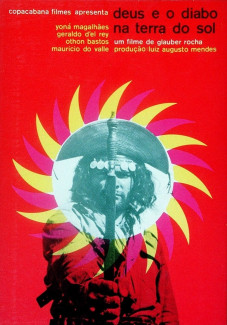The protagonist Manuel is a poor countryman working on a ranch in the deserts of Brazil. After drought kills some of his livestock, Manuel and his Boss dispute over who will incur the losses. In a dramatic escalation of conflict Manuel kills his boss and flees with his wife Rosa. Seeing revenge, the boss’s henchmen murder Manuel’s mother. Manuel and Rosa flee to a mountaintop where they meet a "prophet" named Sebastiao, who represents God. Manuel and Rosa join the group, which really is a cult, and follow Sebastiao’s violent and tyrannical orders. These orders include climbing up a mountain while holding a boulder and sacrificing the innocent blood of a baby. Meanwhile, another character named Antonio das Mortes is hired by the church and landowning elites to kill the entire cult. Just before he arrives to kill them, Rosa takes fate into her own hands and kills Sebastiao. Antonio allows only Rosa and Manuel to live so they can tell their story. Rosa and Manuel then run into Corisco, a fanatic cangaceiro who represents the Devil and is determined to raid homes of the rich and start a war against the government. Antonio and his fellow assassins find Corisco and kill him and his wife. Manuel and Rosa yet again run away from this murderous scene into the horizon, followed by a poignant shot of the ocean.

Describes the setting of a scene in a play or a film. It refers to everything placed on the stage or in front of the camera—including people. In other words, mise en scène is a catch-all for everything that contributes to the visual presentation and overall “look” of a production. When translated from French, it means “placing on stage.”

This is the art of photography and visual storytelling in a motion picture or television show. Cinematography comprises all on-screen visual elements, including lighting, framing, composition, camera motion, camera angles, film selection, lens choices, depth of field, zoom, focus, color, exposure, and filtration. Cinematography sets and supports the overall look and mood of a film’s visual narrative. Each visual element that appears on screen, a.k.a. the mise-en-scène of a film, can serve and enhance the story—so it is the cinematographer’s responsibility to ensure that every element is cohesive and support the story. Filmmakers often choose to spend the majority of their budget on high-quality cinematography to guarantee that the film will look incredible on the big screen.
Editing is the process of putting a film together–the selection and arrangement of shots and scenes. Editing can condense space and time, emphasize separate elements and bring them together, and organize material in such a way that patterns of meaning become apparent. In addition, editing can determine how a film is perceived: for instance, quick, rapid cuts can create a feeling of tension, while a long take can create a more dramatic effect. The first photoplays generally had no cutting, owing to the fact that they were single-reel films; once filming began, you could not stop until the film ran out. (https://filmglossary.ccnmtl.columbia.edu/term/editing/)
Sound is an integral part in a film. It refers to everything that the audience hears including sound effects, words and music. Sound is used in films for various purposes, including: providing the information to the viewer about the location of the scene, heightening the mood, telling the audience about the characters and advancing the plot. Every person who watches a film realizes that the choice of voices, soundtrack and music present in a film affect the way that the viewer perceives a particular film. As a result, the sound is an important and integral element of the film, one that determines the way that the viewer experiences and understands a film as a visual experience.
Narrative analysis is an examination of the story elements, including narrative structure, character, and plot. A narrative can be considered to be the chain of events in a cause-effect relationship occurring in time and space. In order to analyze the narrative of a film, we need to first make the distinction between the plot of the film and the story of the film. This is sometimes referred to as the discourse and story of a film. Narrative may also be called the story thought story mainly refers to the events that describe the narrative.
Film genres are various forms or identifiable types, categories, classifications or groups of films. (Genre comes from the French word meaning "kind," "category," or "type"). These provide a convenient way for scriptwriters and film-makers to produce, cast and structure their narratives within a manageable, well-defined framework. Genres also offer the studios an easily 'marketable' product, and give audiences satisfying, expected and predictable choices. Genres refers to recurring, repeating and similar, familiar or instantly-recognizable patterns, styles, themes, syntax, templates, paradigms, motifs, rules or generic conventions.
Insert bibliography generated by Zotero here
